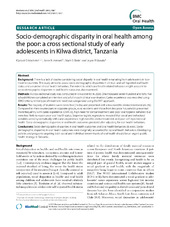| dc.contributor.author | Mashoto, Kijakazi Obed | en_US |
| dc.contributor.author | Åstrøm, Anne Nordrehaug | en_US |
| dc.contributor.author | Skeie, Marit Slåttelid | en_US |
| dc.contributor.author | Masalu, Joyce R. | en_US |
| dc.date.accessioned | 2011-01-04T10:51:37Z | |
| dc.date.available | 2011-01-04T10:51:37Z | |
| dc.date.issued | 2010-04-20 | eng |
| dc.Published | BMC Oral Health 10(7) | en |
| dc.identifier.issn | 1472-6831 | |
| dc.identifier.uri | https://hdl.handle.net/1956/4366 | |
| dc.description.abstract | Background There is a lack of studies considering social disparity in oral health emanating from adolescents in low-income countries. This study aimed to assess socio-demographic disparities in clinical- and self reported oral health status and a number of oral health behaviors. The extent to which oral health related behaviors might account for socio-demographic disparities in oral health status was also examined. Methods A cross-sectional study was conducted in Kilwa district in 2008. One thousand seven hundred and forty five schoolchildren completed an interview and a full mouth clinical examination. Caries experience was recorded using WHO criteria, whilst type of treatment need was categorized using the ART approach. Results The majority of students were caries free (79.8%) and presented with a low need for dental treatment (89.3%). Compared to their counterparts in opposite groups, rural residents and those from less poor households presented more frequently with caries experience (DMT>0), high need for dental treatment and poor oral hygiene behavior, but were less likely to report poor oral health status. Stepwise logistic regressions revealed that social and behavioral variables varied systematically with caries experience, high need for dental treatment and poor self reported oral health. Socio-demographic disparities in oral health outcomes persisted after adjusting for oral health behaviors. Conclusions Socio-demographic disparities in oral health outcomes and oral health behaviors do exist. Socio-demographic disparities in oral health outcomes were marginally accounted for by oral health behaviors. Developing policies and programs targeting both social and individual determinants of oral health should be an urgent public health strategy in Tanzania. | en_US |
| dc.language.iso | eng | eng |
| dc.publisher | BioMed Central | eng |
| dc.rights | Attribution CC BY | eng |
| dc.rights.uri | http://creativecommons.org/licenses/by/2.0 | eng |
| dc.title | Socio-demographic disparity in oral health among the poor: a cross sectional study of early adolescents in Kilwa district, Tanzania | en_US |
| dc.type | Peer reviewed | |
| dc.type | Journal article | |
| dc.description.version | publishedVersion | en_US |
| dc.rights.holder | Copyright 2010 Mashoto et al; licensee BioMed Central Ltd. This is an Open Access article distributed under the terms of the Creative Commons Attribution License (http://creativecommons.org/licenses/by/2.0), which permits unrestricted use, distribution, and reproduction in any medium, provided the original work is properly cited. | |
| dc.identifier.doi | https://doi.org/10.1186/1472-6831-10-7 | |
| dc.identifier.cristin | 349129 | |
| dc.subject.nsi | VDP::Medisinske Fag: 700::Helsefag: 800::Samfunnsodontologi: 802 | nob |

